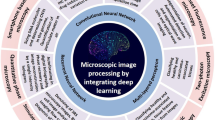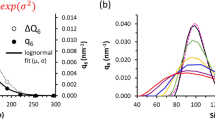Abstract
Cell studies play an important role in the basis of studies on cancer diagnosis and treatment. Reliable viability assays on cancer cell studies are essential for the development of effective drugs. Lens-free digital in-line holographic microscopy has become a powerful tool in the characterization and viability analysis of microparticles such as cancer cells due to its advantages such as high efficiency, low cost, and flexibility to integrate with other components. This study is designed to perform viability tests using fractal dimensions of alive and dead cancer cells based on digital holographic microscopy and machine learning. In the in-line holography configuration, a microscopy assembly consisting of inexpensive components was built using an LED source, and the images were reconstructed using computational methods. The standard US Air Force Resolution Target was used to evaluate the capability of our imaging setup then holograms of stained cancer cells were recorded. To characterize individual cells, 19 different rotational invariant fractal dimension values were extracted from the images as features. An artificial neural network technique was employed for the classification of fractal features extracted from cells. The artificial neural network was compared with four other machine learning techniques through five different classification performance measures. The empirical results indicated that artificial neural networks performed better than compared classification techniques with accuracies of 99.65%. The method proposed in this paper provides a new method for the study of cell viability which has the advantages of high accuracy and potential for laboratory application.








Similar content being viewed by others
References
M. Wei et al., An evaluation approach of cell viability based on cell detachment assay in a single-channel integrated microfluidic chip. ACS Sens. 4(10), 2654–2661 (2019). https://doi.org/10.1021/acssensors.9b01061
K. Yang, J. Wu, S. Santos, Y. Liu, L. Zhu, F. Lin, Recent development of portable imaging platforms for cell-based assays. Biosens. Bioelectron. 124–125(October 2018), 150–160 (2019). https://doi.org/10.1016/j.bios.2018.10.024
J. Sun, A. Tárnok, X. Su, Deep learning-based single-cell optical image studies. Cytom. Part A 97(3), 226–240 (2020). https://doi.org/10.1002/cyto.a.23973
Y. Wu, A. Ozcan, Lensless digital holographic microscopy and its applications in biomedicine and environmental monitoring. Methods 136, 4–16 (2018). https://doi.org/10.1016/j.ymeth.2017.08.013
M. Sher, R. Zhuang, U. Demirci, W. Asghar, Paper-based analytical devices for clinical diagnosis: recent advances in the fabrication techniques and sensing mechanisms. Expert Rev. Mol. Diagn. 17(4), 351–366 (2017). https://doi.org/10.1080/14737159.2017.1285228
J. Li, L. Dai, N. Yu, Z. Li, S. Li, Measurement of red blood cell size based on a lensless imaging system. Biotechnol. Appl. Biochem. (2020). https://doi.org/10.1002/bab.2057
J. Kun, M. Smieja, B. Xiong, L. Soleymani, Q. Fang, The use of motion analysis as particle biomarkers in lensless optofluidic projection imaging for point of care urine analysis. Sci. Rep. 9(1), 17255 (2019). https://doi.org/10.1038/s41598-019-53477-8
J. Mariën, R. Stahl, A. Lambrechts, C. van Hoof, A. Yurt, Color lens-free imaging using multi-wavelength illumination based phase retrieval. Opt. Express 28(22), 33002 (2020). https://doi.org/10.1364/oe.402293
A.B. Dharmawan et al., Nonmechanical parfocal and autofocus features based on wave propagation distribution in lensfree holographic microscopy. Sci. Rep. 11(1), 3213 (2021). https://doi.org/10.1038/s41598-021-81098-7
M. Rempfler et al., Tracing cell lineages in videos of lens-free microscopy. Med. Image Anal. 48, 147–161 (2018). https://doi.org/10.1016/j.media.2018.05.009
M. Roy, D. Seo, S. Oh, J.W. Yang, S. Seo, A review of recent progress in lens-free imaging and sensing. Biosens. Bioelectron. 88, 130–143 (2017). https://doi.org/10.1016/j.bios.2016.07.115
G. Scholz et al., Continuous live-cell culture imaging and single-cell tracking by computational lensfree LED microscopy. Sensors (Switzerland) 19(5), 1–13 (2019). https://doi.org/10.3390/s19051234
Z. El-Schich, A. Mölder, H. Tassidis, P. Härkönen, M.F. Miniotis, A.G. Wingren, Induction of morphological changes in death-induced cancer cells monitored by holographic microscopy. J. Struct. Biol. 189(3), 207–212 (2015). https://doi.org/10.1016/j.jsb.2015.01.010
K. Yamashita, R. Tagawa, Y. Higami, E. Tokunaga, Noninvasive and safe cell viability assay for breast cancer MCF-7 cells using natural food pigment. Biology (Basel) 9(8), 1–14 (2020). https://doi.org/10.3390/biology9080227
F. Piccinini, A. Tesei, C. Arienti, A. Bevilacqua, Cell counting and viability assessment of 2D and 3D cell cultures: expected reliability of the trypan blue assay. Biol. Proc. Online 19(1), 1–12 (2017). https://doi.org/10.1186/s12575-017-0056-3
M.A. Pala, M.E. Çimen, Ö.F. Boyraz, M.Z. Yildiz, A.F. Boz, Meme Kanserinin Teşhis Edilmesinde Karar AğacıVe KNN Algoritmalarının KarşılaştırmalıBaşarım Analizi. Acad. Perspect. Procedia 2(3), 544–552 (2019). https://doi.org/10.33793/acperpro.02.03.47
T. O’Connor, A. Anand, B. Andemariam, B. Javidi, Overview of cell motility-based sickle cell disease diagnostic system in shearing digital holographic microscopy. J. Phys. Photon. (2020). https://doi.org/10.1088/2515-7647/ab8a58
D. De Bels et al., Hyperoxia alters ultrastructure and induces apoptosis in leukemia cell lines. Biomolecules 10(2), 1–14 (2020). https://doi.org/10.3390/biom10020282
Ö.F. Boyraz, M.A. Pala, M.E. Çimen, Mikrobilgisayar TabanlıEl- Bilek Damar Örüntüleri Kullanılarak Biyometrik Kimlik Doğrulama İşleminin YapılmasıA microcomputer-based biometric authentication system using hand-wrist vein patterns. 2019(November), 593–600 (2019)
C.L. Chen et al., Deep learning in label-free cell classification. Sci. Rep. 6(March), 1–16 (2016). https://doi.org/10.1038/srep21471
A. Caliskan, M.E. Yuksel, H. Badem, A. Basturk, Performance improvement of deep neural network classifiers by a simple training strategy. Eng. Appl. Artif. Intell. 67, 14–23 (2018). https://doi.org/10.1016/j.engappai.2017.09.002
Y. Wang, P. Ju, S. Wang, J. Su, W. Zhai, C. Wu, Identification of living and dead microalgae cells with digital holography and verified in the East China Sea. Mar. Pollut. Bull. 163(December 2020), 111927 (2021). https://doi.org/10.1016/j.marpolbul.2020.111927
B. Klinkenberg, A review of methods used to determine the fractal dimension of linear features. Math. Geol. 26(1), 23–46 (1994)
A.O. Öncel, Ö. Alptekin, Fraktal dağılım ve sismolojideki uygulamaları. Jeofizik Derg. 9(1) (1995)
P. Kirci, E.A. Bayrak, The application of fractal analysis on thyroid ultrasound images. Acta Infologica 3(2), 89–90 (2019)
L. Yu, D. Zhang, K. Wang, W. Yang, Coarse iris classification using box-counting to estimate fractal dimensions. Pattern Recognit. 98(11), 1791–1798 (2005)
A. Sezer, A.B. Göktepe, S. Altun, Temel dayanımının fraktal boyut ile incelenmesi (2007)
M.E. Çimen, Ö.F. Boyraz, Z. Garip, İ. Pehlivan, M.Z. Yildiz, A.F. Boz. Görüntü İşleme Tabanlı Kutu Sayma Yöntemi ile Fraktal Boyut Hesabı için Arayüz Tasarımı. Politek. Derg. 24(3), 867–878 (2021). https://doi.org/10.2339/politeknik.689421
M.E. Cimen, O.F. Boyraz, M.Z. Yildiz, A.F. Boz, A new dorsal hand vein authentication system based on fractal dimension box counting method. Optik. 226, 165438 (2021)
A.K. Bisoi, J. Mishra, On calculation of fractal dimension of images. Pattern Recognit. Lett. 22(6–7), 631–637 (2001). https://doi.org/10.1016/S0167-8655(00)00132-X
E. Demireli, M. Ural, Hurst Üstel katsayisi araciliğiyla fraktal yapi analizi ve İMKB’de bir uygulama. Atatürk. Üniversitesi İktisadi ve İdari Bilim. Derg. 23(2), 243–255 (2009)
A. Uyar, D. Öztürk, Fraktal analizin yeryüzü araştırmalarında kullanılması. Afyon Kocatepe Üniversitesi Fen ve Mühendislik Bilim. Derg. 17(4), 147–155 (2017)
Q. Huang, J.R. Lorch, R.C. Dubes, Can the fractal dimension of images be measured? Pattern Recognit. 27(3), 339–349 (1994). https://doi.org/10.1016/0031-3203(94)90112-0
D.G. Voelz, Computational Fourier optics: a MATLAB Tutorial (SPIE Press, Bellingham, 2011), pp. 116–124
T. Latychevskaia, H.W. Fink, Practical algorithms for simulation and reconstruction of digital in-line holograms. Appl. Opt. 54(9), 2424–2434 (2015). https://doi.org/10.1364/AO.54.002424
Z. Ren, Z. Xu, E.Y. Lam, End-to-end deep learning framework for digital holographic reconstruction. Adv. Photon. 1(01), 1 (2019). https://doi.org/10.1117/1.ap.1.1.016004
L. Hervé et al., Alternation of inverse problem approach and deep learning for lens-free microscopy image reconstruction. Sci. Rep. 10(1), 1–12 (2020). https://doi.org/10.1038/s41598-020-76411-9
S. Feng, J. Wu, Differential holographic reconstruction for lensless in-line holographic microscope with ultra-broadband light source illumination. Opt. Commun. 430(August 2018), 9–13 (2019). https://doi.org/10.1016/j.optcom.2018.08.033
H.A. Ilhan, M. Dogar, M. Ozcan, Digital holographic microscopy and focusing methods based on image sharpness. J. Microsc. 255(3), 138–149 (2014). https://doi.org/10.1111/jmi.12144
A. Bigerelle, Maxence; IOST, “Fractal dimension and classification of music’’. Chaos Solitons Fractals 11(14), 2179–2192 (2000)
S.H. Rezatofighi, H. Soltanian-Zadeh, Automatic recognition of five types of white blood cells in peripheral blood. Comput. Med. Imaging Graph. 35(4), 333–343 (2011). https://doi.org/10.1016/j.compmedimag.2011.01.003
M. E. Çimen, Z. Garip Batık, M. A. Pala, B. A. Fuat, A. Akgul, Modelling of chaotic motion video with artificial neural networks. Chaos Theory Appl. 1(1), 38–50 (2019)
K. Kourou, T.P. Exarchos, K.P. Exarchos, M.V. Karamouzis, D.I. Fotiadis, Machine learning applications in cancer prognosis and prediction. Comput. Struct. Biotechnol. J. 13, 8–17 (2015). https://doi.org/10.1016/j.csbj.2014.11.005
M. Alcin, I. Koyuncu, M. Tuna, M. Varan, I. Pehlivan, A novel high speed artificial neural network-based chaotic true random number generator on field programmable gate array. Int. J. Circuit Theory Appl. 47(3), 365–378 (2019). https://doi.org/10.1002/CTA.2581
M. Tuna, A. Karthikeyan, K. Rajagopal, M. Alcin, İ Koyuncu, Hyperjerk multiscroll oscillators with megastability: analysis, FPGA implementation and a novel ANN-ring-based true random number generator. AEU Int. J. Electron. Commun. 112, 152941 (2019). https://doi.org/10.1016/J.AEUE.2019.152941
S. Vaidyanathan et al., A novel ANN-based four-dimensional two-disk hyperchaotic dynamical system, bifurcation analysis, circuit realisation and FPGA-based TRNG implementation. Int. J. Comput. Appl. Technol. 62(1), 20–35 (2020). https://doi.org/10.1504/IJCAT.2020.103921
Acknowledgements
This work was supported by Sakarya University of Applied Science Scientific Research Projects Coordination Unit (SUBU BAPK, Project Number: 2020-01-01-011). The author, Muhammed Ali PALA, is grateful to The Scientific and Technological Research Council of Turkey for granting a scholarship (TUBITAK, 2211-C) for him Ph.D. studies.
Author information
Authors and Affiliations
Corresponding author
Rights and permissions
About this article
Cite this article
Pala, M.A., Çimen, M.E., Akgül, A. et al. Fractal dimension-based viability analysis of cancer cell lines in lens-free holographic microscopy via machine learning. Eur. Phys. J. Spec. Top. 231, 1023–1034 (2022). https://doi.org/10.1140/epjs/s11734-021-00342-3
Received:
Accepted:
Published:
Issue Date:
DOI: https://doi.org/10.1140/epjs/s11734-021-00342-3




